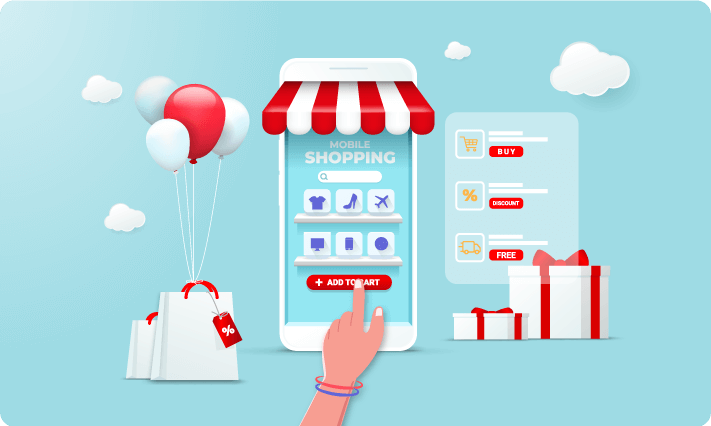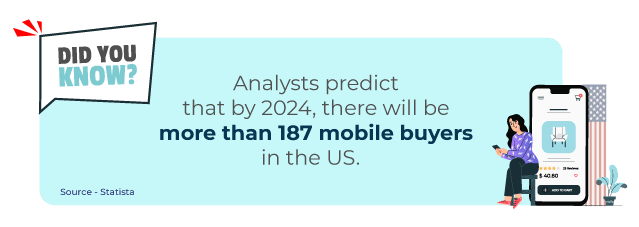The huge growth of mobile devices and the penetration of internet services have driven many retail and eCommerce brands to aggressively adopt more mobile-centric strategies. It’s just not the medium of communicating with your friends and family but also an important channel for brands to communicate with their customers.
With the ease of m commerce (mobile commerce) and with the growing trend people are most likely to jump on purchasing via mobile device, website, and app on their mobile device. Many brands are launching their apps and consumers are ready to accept the mobile device as a mechanism to purchase online. Deploying a chatbot helps to deliver a better CX and this contributes to switching from store purchase to a mobile device purchase.
What is Mobile Commerce?
Simply put, Mobile commerce is also sometimes referred to as m-commerce which involves shopping through a mobile device (mostly smartphone), and all transactions are performed over a mobile device. It mostly aims to enhance CX on smartphones which will eventually drive higher conversion rates and revenue. Typically, m-commerce is classified into three categories, mobile shopping, mobile banking, mobile payments, and digital wallets.
Understanding Mobile commerce
The phenomenal growth of mobile devices and the ease of internet access is dominating the new generation and is the reason behind m-commerce. As more and more customers are switching towards m-commerce (mobile commerce) it’s the next step in the evolution of eCommerce. It’s no secret that customers prefer to shop on mobile phones and put all the retail world at consumers’ fingertips. They get convenience to shop from anywhere and anytime and get easy access to customer support via a simple text.
M-commerce v/s eCommerce
- The basic difference between e-commerce and m-commerce is that eCommerce shopping is done over desktops and laptops with the help of the internet and m-commerce means that all the transactions are done via mobile devices like smartphones, tablets. On mobile devices, you can push notifications and for eCommerce, you can share promotional emails.
- The location tracking on eCommerce is done via the IP address and on the other hand in m-commerce, you will be able to track location via GPS, Wi-Fi, and cellular connections.
- While in eCommerce shopping experience is highly dependent on computers and websites which makes it lesser mobility. On m-commerce, you can do the personalization and deliver a customized shopping experience where customers can make prompt shopping decisions.
Types of Mobile Commerce
 Mobile Shopping:
Mobile Shopping:
The mobile device plays an important role in the success of mobile shopping. But what a customer expects today is an omnichannel experience, they want their brands to be available on their preferred channel. For instance, if a customer scans a QR code in a retail store they can do the shopping on Viber Chatbot and continue their shopping.
 Mobile Banking:
Mobile Banking:
Mobile banking is also popularly known as “Net Banking” which is like online banking. Financial institutes especially banks use both SMS, apps, and chatbots to send out alerts and account activities. With the help of the WhatsApp Chatbot, customers can view their account balance, bank statement, fund transfer, review loans, and many other transactions by just communicating via WhatsApp in real-time.
 Mobile Payments:
Mobile Payments:
Mobile payment is an alternative to the traditional channels of payments such as cash, cheque, credit/debit cards which are also known as Mobile Money Transfer, mobile money, or m-payments. Due to physical distancing, customers prefer to use contactless payments, and that is where mobile payments come in handy.
Benefits of using Mobile Commerce
Better User Experience:
UX is one of the most important components when customers are purchasing via smartphones and tablets. Personalization also helps to provide a unique and relevant user experience to the customers. For instance, if a customer wants to buy a product from a mobile website and with the WhatsApp Chatbot button they can initiate a conversation over WhatsApp. This makes a conversation between customer and brand fast and convenient.
Provides a Seamless Checkout Process:
When a person buys from a traditional website it takes a bit longer time to complete the transaction. But on the other hand, if a customer does the transaction via Viber Business Messages, then all the lengthy checkout process is minimized and provide a seamless check-out process. With a great purchasing experience, your brand is bound to attract more customers and have a high chance of turning your existing customers into repeat customers.
Newer Channel to Reach out Customers:
Traditional websites have been there for many years, but mobile apps would be a different experience for a customer to purchase. All the functionalities that a typical website has can be given a mobile app like the search feature, product prices, resources section, and many more. The push notifications added with discounts can help you increase your sales. All the tailor-made functionalities are available that will let you target your customers.
M Commerce: Advantages
Builds a global customer base:
The internet and mobile device have the potential to build a global customer base as customers can purchase at their convenience. It constructs another channel for marketing were utilizing the mobile applications can be done to the utmost and offer a better customer experience.
Provide access to user data:
The time customer logins into the brand’s mobile application, the user information starts getting stored and the brand gets access. When there’s a campaign planned or want to share customized messages to customers, they can easily access that data and send the latest collections and brand offers to easily attract them.
Better User Experience:
Providing a better UX can turn new customers into repeat customers. A customer can log in to the app and check what they want to have and check out at their convenience. M-commerce can also drive impulse purchases to customers with different flash offers shared via push notifications or sending personalized messages.
M Commerce: Disadvantages
Security Issues:
Customers have a lot of concerns with the safety of their private information and sometimes they are not ready to share it with the brand. For instance, for online payments brands ask for a credit/debit card number and bank account details, many customers have trust issues with sharing personal information with a brand.
Connectivity Issues:
If a customer is purchasing online, they need an internet connection to complete the transaction. There’s a penetration in internet service still in rural areas we see a lack of smartphones and internet connections. Without a proper connection, your customer will not be able to view the mobile design and the brand might miss the selling opportunity.
Shipping Cost:
The mobile transaction which is done to buy any product may add up shipping costs. But by setting a minimum for free shipping and low cost for shipping the products will encourage buyers to continue shopping and will increase the number of sales.
Also Read: 5 Strategies to Scale Up Your eCommerce Sales with SMS Marketing
Mobile Commerce: Top Trends in 2022
Increase in Omnichannel mobile shoppers:
Mobile apps are going to drive omnichannel experience in the future as it has the power of integration, real-time reports, and analytics, and many more. Omnichannel mobile shopping will give a consistent shopping experience from desktop to the app to in-store.
Mobile Chatbots:
Mobile Chatbots is one of the latest trends we see for engagement between businesses and consumers. It allows customers to users to use voice, text, images, gifs, product catalogs while shopping, and with the help of Natural Language Processing (NLP), it bridges the gap between programming languages and human languages.
Voice Shopping:
Voice shopping is the next big trend and is shaping the future of m-commerce. As omnichannel shopping has become the norm going ahead with voice shopping will help brands to deliver an enhanced shopping experience. As per the latest research done by Juniper forecasts the voice search market will skyrocket to $80 billion by 2023. This means that we are still in the growth stage, and it will tend to move upward.
The Future of M-commerce:
We all know that the future of mobile commerce looks positive and more promising. It’s going to attract more retailers and we will see more m-commerce apps in the future. The chatbots are gaining more attention there will be more integration seen in mobile banking. Mobile accessibility is changing the behavior of consumer habits. The shopping experience remains the same on mobile devices as compared to brands’ websites, in fact, more they get more new features and personalization while using mobile apps.
Want to wider your share of shopping on mobile devices? We’re here to help you out.
Talk to one of our Experts NOW!Brands are optimizing m-commerce has enhanced their shopping experience and with minimal efforts, customers can purchase the right product and enable them to complete their purchase in one go. Smartphones are an inseparable part of our lives now and the capability that m-commerce holds in the future is unremarkable and to change consumer shopping habits. To make your m-commerce more dynamic and wish to deliver better CX our experts will help you out.




 Mobile Shopping:
Mobile Shopping: Mobile Banking:
Mobile Banking: Mobile Payments:
Mobile Payments:



